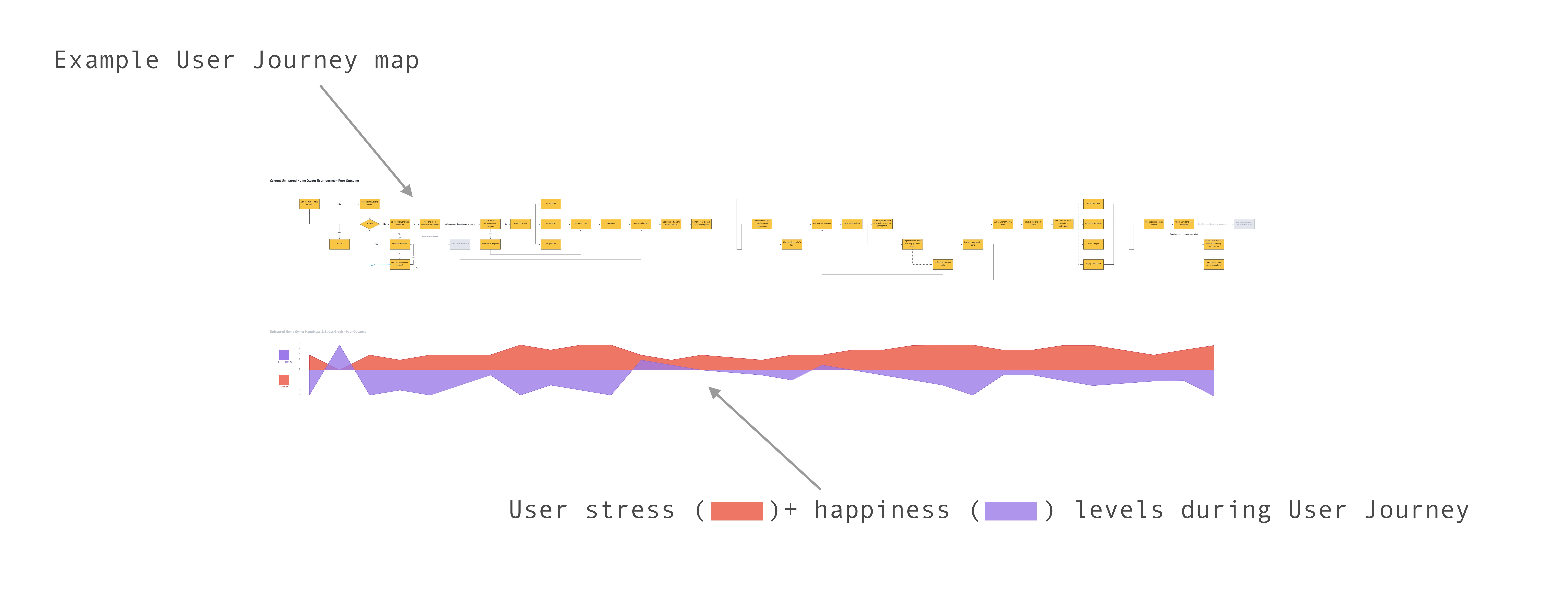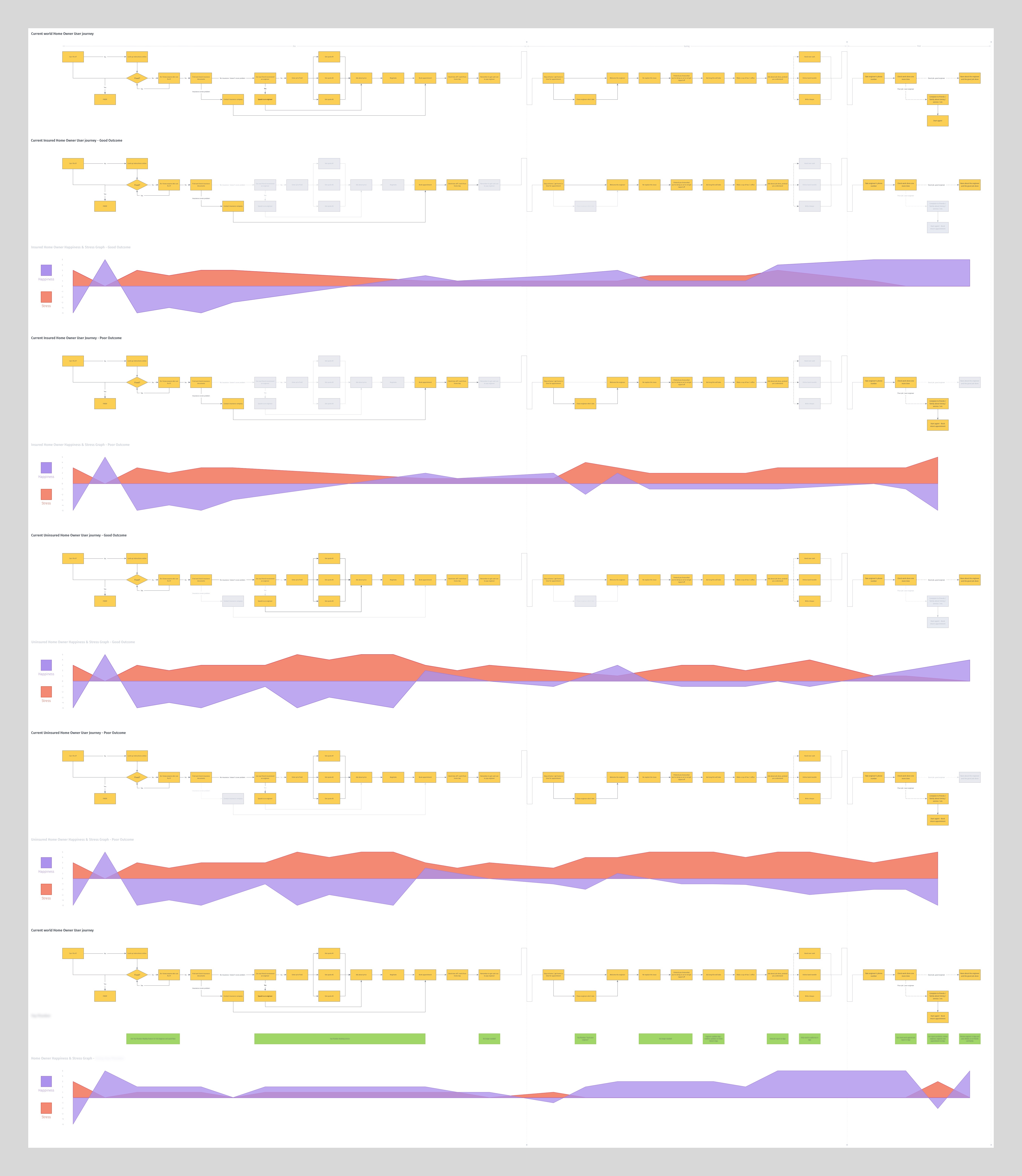JMCQUARRIE.co.uk
James McQuarrie is a UK based Product Leader who helps teams discover, design, build and deliver digital products and services that delight their users.
Designing a startup's product based on insights learnt from mapping out an end to end Customer Experience Journey
TL;DR
Mapping the end to end Customer Journey for getting someone to help with a home repair issue revealed three key insights:
- to excel in the market a company must control the full end to end experience
- communication throughout the process is key to delivering a great customer experience
- the experience is compound; fail to meet expectations early and it’s harder to recover the Customer’s confidence.
Insights that informed the core design principles of our home repair startup.
 Example of an end to end Customer Journey map with the emotional state of a Customer mapped across each stage of the process
Example of an end to end Customer Journey map with the emotional state of a Customer mapped across each stage of the process
The detail
It’s 2015. I’m sitting in a small meeting room in an office in Kings Cross, London.
I’m with Ben, a friend and ex-colleague. He’s commandeered the meeting room from the multinational company whose office this is because they’ve asked him to solve a problem they have. It’s now his project’s war room.
We’re surrounded by post-it notes and printouts and ideas scribbled on bits of paper stuck all over the walls, windows and doors of the room.
The problem the big corporate want to solve is how to reach a younger, “digitally-native” audience.
They’re an insurance company who provide home repair insurance.
Their customer base is “mature”. Younger people don’t buy insurance.
They don’t want to be disrupted by some young startup. Or, rather, if they’re going to be disrupted by some young startup, they want to own a stake in that startup.
That’s why Ben and I are here. He’s building the startup.
He’s asked me to help.
He’s been at this for a few weeks already. Hence the notes and paper on the walls.
He’s been interviewing people and learning about their experiences of using home repair services. Finding plumbers, electricians, heating engineers, etc.
Most are not great.
He’s started to map out the typical process that people go through when they have a problem that needs a tradesperson to come fix it.
The process varies by severity and type of issue but can broadly be summarised as consisting of three parts:
- Pre fix
- During fix
- Post fix
They break down roughly as:
Pre fix
- discover / cause the problem(s) that need fixing (eg come home to find a flooded kitchen floor)
- source expert help (ask friends / family to recommend someone. Failing that, try the local facebook group, or yellow pages, or google)
- arrange for someone to come over “asap”, for a fee. Then wait a lot longer than expected before they arrive.
During fix
- show them the issue and listen to them explain the technical reasons they can’t fix it right this minute, and why they’ll be back tomorrow or the day after
- wait some more
- let them in and offer them a drink while you hope they get on with the work
- watch them come and go several times through the day to get parts / materials / etc
- listen to them explain what they’ve done and how it’s been fixed
- pay them
- say goodbye.
Post fix
- test the fix (turn the taps on full, or turn the heating right up to see what happens)
- cross your fingers you don’t have another problem any time soon.
The process made sense to me and matched the experiences of others who I’d spoken with in preparation for the briefing.
To be able to start working out where there were opportunities to improve this process and what those opportunities were we needed to delve deeper. I did some more research.
Over the course of the following few days I drew up a number of different versions of the process based on different real life scenarios that we’d heard about via our research.
I drew up the “best case” scenarios, of finding someone via a family recommendation or via an insurance company. The tradesperson being able to come round within a few hours and fix the issue first time.
I drew up worst case scenarios; not having insurance that covered the issue and not being able to find someone via a recommendation. The tradesperson not turning up on time and having to make several visits before the issues were fixed.
In total I drew up four variations of the customer experience journeys that represented the scenarios we’d heard about. I then mapped both the customer’s stress and satisfaction (or happiness) at each point within those representative journeys.
 Diagrams of the final versions of our Customer Journey maps with emotional states mapped throughout. The maps at the bottom of the diagram record our initial thoughts about how our service would work and the experience we were aiming to offer.
Diagrams of the final versions of our Customer Journey maps with emotional states mapped throughout. The maps at the bottom of the diagram record our initial thoughts about how our service would work and the experience we were aiming to offer.
These allowed Ben and I to start identifying where we could make the most impact and improve the customer experience of getting a tradesperson into your home and fixing it.
At least that was the theory. In practise what the maps showed us was that to be able to truly deliver a great service and experience to homeowners we needed to own and redesign elements of the entire end to end experience.
Owning the whole experience
Our insight was that if you didn’t control any one element of the process you’d be exposing yourself to someone else in the chain letting the customer down, leaving them with a bad impression of the entire experience.
Going through the process of mapping out the customer journey and thinking about where we could improve it also helped us uncover two other insights that became key to how we designed our improved offering:
- communication is key
- the experience is compound.
Communication is key to a great experience
Firstly; as with most things, good communication throughout the experience was key to both winning and keeping a customer’s trust.
When we analysed the points in the existing process that were failing the customer the most, they were all related to poor communication that failed to set the right expectations. If a tradesperson didn’t explain why they needed a special part that would take hours to collect, customers got frustrated. If a tradesperson didn’t arrive on time, customers got frustrated. If the job ended up costing more than was originally quoted, customers got frustrated.
Many of the issues people reported could be solved by improving the communication between the tradespeople doing the job and the customer, but also by setting the right expectation for the customer in the first place. Explaining the difference between diagnosing the cause of a problem and the process of fixing it. Explaining what to expect when someone arrives in your home. Explaining how prices are calculated, showing customers receipts for parts, etc.
Experience is compound
The final insight our mapping exercise uncovered was that the overall happiness / stress levels of customer throughout the process were compound. If you started badly, you’d make it extremely hard for yourself to recover the situation. This lead us to our most radical design decision within our own solution; getting an expert into your home as quickly as possible became key to helping our customers. To do that we would use video calls to get experts eyes on the problem within seconds or minutes of a customer needing help, instead of hours.
The anxiety customers feel when faced with a home repair issue is often huge, especially if it’s something they’ve not encountered before.
Having an expert reassure them it can be fixed and, where possible, help them stop it getting any worse, makes a massive difference to their stress levels. In the existing market it would be an hour at best before a tradesperson could be in your home and turning off the water, or explaining how they could fix the issue. Often that hour would turn into two or three.
We believed that if we could get reassuring help and advice to them within minutes we’d be able to make delivering a great customer experience throughout the rest of the process much much more likely. If we could do that, we’d be able to win the customers trust. If we could gain their trust, we’d become their “go-to” service whenever they needed help or advice about their home repair issues.
That’s the story of how we established the core design principles for a new digital product and service by first mapping out the end to end Customer Journey of existing offerings in the marketplace.
 Photos of various stages in the Customer Journey mapping process. Initial post-it note version on the left, and different iterations of the final maps in the middle on and on the right
Photos of various stages in the Customer Journey mapping process. Initial post-it note version on the left, and different iterations of the final maps in the middle on and on the right